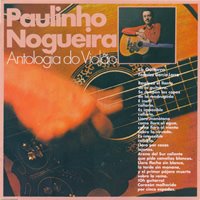
Clique aqui para baixar o disco/Download the album - RapidShare
........................................................
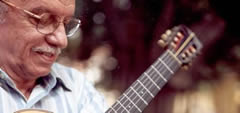 A história do violonista Paulinho Nogueira começa em Campinas, interior de São Paulo. Aos 10 anos, aprendeu a tocar violão com o pai, nas rodas de cantoria que aconteciam em sua casa. Uma das primeiras músicas de que se lembra de ter aprendido a tocar foi Bispo de Rosas, de Canhoto.
A história do violonista Paulinho Nogueira começa em Campinas, interior de São Paulo. Aos 10 anos, aprendeu a tocar violão com o pai, nas rodas de cantoria que aconteciam em sua casa. Uma das primeiras músicas de que se lembra de ter aprendido a tocar foi Bispo de Rosas, de Canhoto.Anos depois, durante a juventude, veio a São Paulo para ser desenhista, mas nunca abandonou a vontade de viver de música. "Felizmente essa carreira não deu certo, senão ate hoje estaria mexendo com desenho". Até que um de seus irmãos conseguiu que ele começasse a tocar numa boate no centro de São Paulo. "Achei que fosse um emprego provisório, mas acabei gostando daquilo." Depois, passou a se apresentar no Bar Michel, famoso entre os artistas da época, cantando nos mesmos palcos que Ângela Maria, Johnny Alf, Dorival Caymmi...
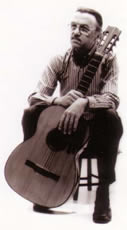 Paulinho se lembra que quando uma de suas grandes influências foi Anibal Augusto Sardinha, mais conhecido como Garoto.
Paulinho se lembra que quando uma de suas grandes influências foi Anibal Augusto Sardinha, mais conhecido como Garoto.De 1960 (quando gravou seu primeiro disco, A Voz do Violão) são 26 LPs, seis CDs, turnês no mundo inteiro - incluindo uma viagem a Cuba em 1979 com artistas brasileiros, a convite de ninguém menos que Chico Buarque.
O violonista passou a ficar conhecido quando gravou seus primeiros discos. "Mas o que impulsionou minha carreira mesmo foi a Bossa Nova. O movimento dava muito força para a música instrumental e eu já tocava muito, fazia solos... Quando surgiu o programa O Fino da Bossa, comecei a aparecer e todo ano gravava um disco, com músicas de Tom Jobim, Vinícius de Moraes, Edu Lobo, Roberto Menescal...", recorda.
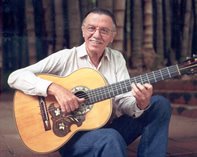 Hoje, aos 71 anos, Paulinho Nogueira, já virou verbete, definição de violonista genial: deitou modernidade no violão quando a bossa-nova estava no auge, fez sucesso como compositor e cantor (sua canção Menina estourou nos anos 70), dividiu o palco com outros bambas, mas intuiu que teria um papel ainda mais importante nos bastidores. Tornou-se um disputadíssimo professor de violão, criou um método de harmonia. Em 69, desenhou a craviola (instrumento de doze cordas, que acabou exportado para os EUA e a Europa) e foi mestre de um sem-número de músicos, entre eles, um futuro parceiro de disco: Toquinho.
Hoje, aos 71 anos, Paulinho Nogueira, já virou verbete, definição de violonista genial: deitou modernidade no violão quando a bossa-nova estava no auge, fez sucesso como compositor e cantor (sua canção Menina estourou nos anos 70), dividiu o palco com outros bambas, mas intuiu que teria um papel ainda mais importante nos bastidores. Tornou-se um disputadíssimo professor de violão, criou um método de harmonia. Em 69, desenhou a craviola (instrumento de doze cordas, que acabou exportado para os EUA e a Europa) e foi mestre de um sem-número de músicos, entre eles, um futuro parceiro de disco: Toquinho. Hoje, quase quatro décadas de sua estréia no vinil, Paulinho Nogueira lança Chico Buarque - Primeiras Composições, desta vez em homenagem a um dos maiores compositores brasileiros.
************************
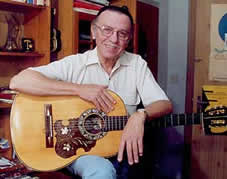 The youngest of six children, Paulinho Nogueira was born into an artistic, musical family in Campinas, São Paulo on October 8th, 1927. His father, Joaquim Gabriel was a cultured man who played classical guitar. Two of his brothers, João and Celso, who were to play crucial roles in his career, were fine players as well.
The youngest of six children, Paulinho Nogueira was born into an artistic, musical family in Campinas, São Paulo on October 8th, 1927. His father, Joaquim Gabriel was a cultured man who played classical guitar. Two of his brothers, João and Celso, who were to play crucial roles in his career, were fine players as well.It was João who taught his youngest sibling his first guitar chords and Paulinho became obsessed with the instrument from day one. When Joaquim would leave the house, the 10 year old Paulinho would sneak into his father's closet and pluck away on his 1937 Del Vecchio. Eventually the instrument was given to him and it has remained with him until this day. It has, in fact, been utilized on all of his recordings including the most recent, Reflexões.
Paulinho's talent was evident early on and his parents wasted no time in finding a fine classical guitar teacher to instruct him. However, this was not to be. One day, the professor played a piece and then placed the sheet music on the stand for Paulinho to play. He proceeded to execute it flawlessly except for one detail, the sheet music was not the piece that the teacher had performed. The teacher concluded that the boy had his own muse to follow and that was the end of his formal guitar education.
Radio played a huge role in Brazilian culture up until the advent of television. In the 1930s and 40s Rio de Janeiro was still the capital of Brazil and the "Radio Nacional" station with its gamut of stars such as Carmen Miranda, Pixinguinha, Radamés Gnattali and other giants could be heard throughout the land. No one, though, had a greater impact on Paulinho than the immortal Anibal Augusto Sardinha better known as "Garoto". A weekly hour-long broadcast featuring the brilliant guitar innovator was religiously tuned into at the Nogueira household. Even his beloved soccer took a back seat to it. Paulinho reflects, "Garoto was my real teacher although I never met him personally. Since it was pretty easy for me to pick things out, I'd listen to him with guitar in hand and cop whatever I could. Some of his style rubbed off on me by osmosis. I consider him the only idol that I ever had in my career. My first arrangements were strongly influenced by him".
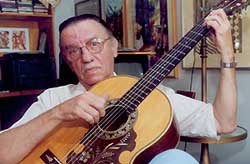 American motion pictures of the 1930s and 40s also caused a lasting impression. At one movie session, Paulinho recalls running home to figure out a dissonant chord on the soundtrack. When he finally discovered the diminished chord that he was looking for, it was as if he had found the Holy Grail. The major 6th chord followed soon after.
American motion pictures of the 1930s and 40s also caused a lasting impression. At one movie session, Paulinho recalls running home to figure out a dissonant chord on the soundtrack. When he finally discovered the diminished chord that he was looking for, it was as if he had found the Holy Grail. The major 6th chord followed soon after.Between Garoto's phenomenal fretwork which preceded Bossa Nova by 20 years and the American pictures from the same period, Paulinho's musical roots were firmly planted.
While still in his early teens, he joined his brother Celso's "Grupo Kacique" or "Indian Chief Group" which performed at the town square and local radio station in Campinas. Although they didn't receive any pay for their work, it was rewarding insofar as it provided exposure and experience.
Paulinho's creativity had manifested itself in other ways and a 1948 painting of Rio de Janeiro based on brother Joao's micro-sculpture won 1st prize at the "Salão de Primavera". João went on to become a highly respected artist in his own right and eventually had his work exhibited at MASP, the prestigious art museum of São Paulo.
The hustle and bustle of Brazil's largest city beckoned and in 1953, upon João's invitation, Paulinho headed for the thriving metropolis of São Paulo. The nightlife in those days was intense, exciting and relatively safe. His first truly professional engagement was at the Itapoan nightclub where he performed from 10:00 PM until 5:00 AM every night. The gig lasted for 3 years and was an immensely valuable experience. He became enamored with the musician's lifestyle, which fit his bohemian personality like a glove.
As a rising young talent, Paulinho's prestige grew and he began to work at "Bar Michel" where he met Dick Farney (considered the Brazilian Sinatra and an idol to the generation that would later create Bossa Nova), Antonio Maria (the lyricist of "Manhã de Carnaval"), Silvio Caldas, Aracy de Almeida, Isaurinha Garcia and other Brazilian top stars of the time.
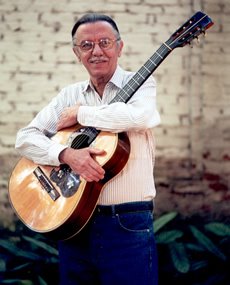 1958 proved to be a magical year for Paulinho and for Brazil. It was the year that the national soccer team won the world cup for the first time and the planet got its first glimpse of Pelé. Maria Ester Bueno won the doubles in Wimbledon, the Cinema Novo was revitalizing local filmmaking and Bossa Nova was starting to make a big splash. Juscelino Kubitchek, a democratically elected president, was attempting to modernize the nation swiftly through his "50 years in 5" program and optimism swept the land. It was also the very same year that Paulinho recorded his first LP, "A Voz do Violão" ("The voice of the guitar"), a superb solo guitar recital which already revealed a major new talent. His distinct sound, partially the result of his not using the nails of his right hand on the nylon strings is fully evident as is his unique playing style. The recording was released early the following year.
1958 proved to be a magical year for Paulinho and for Brazil. It was the year that the national soccer team won the world cup for the first time and the planet got its first glimpse of Pelé. Maria Ester Bueno won the doubles in Wimbledon, the Cinema Novo was revitalizing local filmmaking and Bossa Nova was starting to make a big splash. Juscelino Kubitchek, a democratically elected president, was attempting to modernize the nation swiftly through his "50 years in 5" program and optimism swept the land. It was also the very same year that Paulinho recorded his first LP, "A Voz do Violão" ("The voice of the guitar"), a superb solo guitar recital which already revealed a major new talent. His distinct sound, partially the result of his not using the nails of his right hand on the nylon strings is fully evident as is his unique playing style. The recording was released early the following year.The late 50s and early 60s are often referred to as the Bossa Nova years. João Gilberto's landmark recording of "Chega de Saudade" proved to be the dividing line between the old and the new. In 1959 "Black Orpheus" won the Grand Prize at the Cannes Film Festival and its soundtrack - composed by A.C. Jobim and Luiz Bonfá - introduced the world at large to the gentle sounds that were revolutionizing "the country of the future". By the time Paulinho entered the studio to record his 2nd LP in 1960, he too had become one of the major exponents of the new sound. A picture of the recently inaugurated capital, Brasília, graced its cover.
The nylon-string guitar, or "violão" as it's called in Portuguese, began to enjoy an unprecedented surge in popularity around this time and Paulinho was much sought after by students. One of his pupils was Toquinho who would go onto international fame after teaming up with poet/songwriter Vinícius de Moraes.
Interestingly enough, it was a vocal tune called "Menino, Desce Daí" on his third LP (1961) which gave him his first big hit, thus attracting a larger following. Guitar instrumentals continued to dominate his recordings nonetheless.
In the mid-sixties, Paulinho was part of the cast of "O Fino da Bossa", a weekly TV program hosted by singers Elis Regina and Jair Rodrigues. The program which featured the Zimbo Trio, Tamba Trio, Jongo Trio and guest performances by the likes of Marcos Valle, Baden Powell, Edu Lobo, Dorival Caymmi, A.C. Jobim helped spread Paulinho's name throughout Brazil. He went on to record the classic "Carinhoso" with Elis on one of her LPs.
During rehearsals before one memorable show, someone suggested that Paulinho and Baden Powell perform together though they had never done so before. Because they were Brazil's top two guitarists at the time, the press had invented a rivalry between them which never actually existed. Half an hour before show time, they decided to play "Odeon". In doing so, they broke one of the show's golden rules - because there were so many artists in the cast, encores were forbidden due to TV broadcasting time restrictions. In this case, though, the audience response was overwhelming and the duo was obliged to return for another number. Unfortunately, the tapes of "O Fino da Bossa" as well as many other historically important programs were destroyed in one of the many fires that "TV Record" network studios suffered.
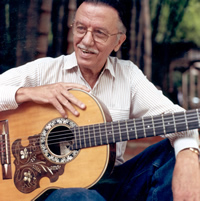 As the "Jovem Guarda" pop movement, led by Roberto Carlos began to take over the musical scene during the second half of the sixties, Bossa Nova went into decline in Brazil despite enjoying widespread popularity in other parts of the world. Concerts of this genre became few and far between. Having the responsibility of a family to support, Paulinho came up with an idea that would generate income without relying on his presence. A year later, his guitar harmony method book was published. The day after his appearance on TV to launch the book, it was already sold out. It became a best seller and is now in its 20th printing.
As the "Jovem Guarda" pop movement, led by Roberto Carlos began to take over the musical scene during the second half of the sixties, Bossa Nova went into decline in Brazil despite enjoying widespread popularity in other parts of the world. Concerts of this genre became few and far between. Having the responsibility of a family to support, Paulinho came up with an idea that would generate income without relying on his presence. A year later, his guitar harmony method book was published. The day after his appearance on TV to launch the book, it was already sold out. It became a best seller and is now in its 20th printing.Paulinho's passion for visual art also expressed itself in a unique way in the late 60s. After sketching some guitar shapes, he decided to design a guitar. He came up with six different possibilities. Shortly after, he visited his friend Gianini, the owner of the guitar company which goes by the same name, and asked him to build a guitar based upon one of the designs. Gianini liked the idea so much that the resulting instrument, known as the "Craviola" due to it's unique sound which is a cross between a Cravo (harpsichord) and a viola (small double-string guitar) became a successful export for the firm. In an edition of Britain's "Melody Maker" music magazine, Jimmy Page of Led Zeppelin fame appears in a photo with his own Craviola.
In 1970, Paulinho scored a number #1 hit with his song "Menina", which once more featured his vocals. It ended up on one of Brazil's soap operas which propelled the song to even greater heights and was eventually recorded in French and Italian. It is a popular song in Brazil to this day.
Throughout the 60s, 70s and 80s, Paulinho continued to receive prestigious awards such as the "Pinheiro de Ouro" from the state of Paraná and best musician of the year from the "Estado de São Paulo", one of Brazil's most important newspapers. He continued to perform regularly and release an LP almost every year in addition to teaching.
A historic concert in Cuba, organized by the brilliant Brazilian composer Chico featured Djavan, Gonzaguinha, Paulinho da Viola, Simone, Nelson Ayres and other big names. When Paulinho played Lecuona's "Malagueña" on his 1937 Del Vecchio for the crowd of over 10,000 he brought the house down.
In 1985, still seeking to expand his horizons, Paulinho composed a series of instrumental guitar pieces that resonate with his unique and innovative approach to his beloved, inseparable "violão". In 1989 he was one of the artists chosen to perform in the "Violões" project, a series of concerts that featured Brazil's most important guitarists. Carlos Barbosa-Lima, Sergio and Odair Assad, Turíbio Santos, Egberto Gismonti, Sebastião Tapajós, Rafael Rabello, Hélio Delmiro, Paulo Bellinati, Marco Pereira and Ulisses Rocha were among the selected players.
Paulinho released various instructional videos during this period. One in particular, "Violão em Harmonia" offers an interesting look at his approach to his instrument.
In the early 90s, Paulinho was part of another important project dedicated to Brazilian instrumental Music. The "Música Viva" series gathered a stellar touring cast which included Hermeto Pascoal, Egberto Gismonti, Arthur Moreira Lima, and Wagner Tiso among others and organized various concerts in smaller cities which wouldn't normally have access to these artists, in addition to performances in big city venues. The series was also released on CD.
Throughout this decade, Paulinho Nogueira has gone on making occasional forays into the studio. Reflexões is his first CD for an American label.

 Br-Instrumental no Twitter
Br-Instrumental no Twitter





6 comentários:
What a beautiful album! His tone on the steel-stringed guitar is quite distinctive; he plays it in a nylon-stringed style (to my ears) which is very interesting. His arrangements are also very unusual; virtuosic but always serving the songs, which is how it should be.
Having just gotten two nylon Craviolas from 1970 and 1978 (thanks, eBay!), I now have another unreachable goal to aim for. Obrigado, Paulinho!
Por favor coloque links de outros sharers pra fazer download.
www.megaupload.com
www.zshare.net
www.4shared.com
www.badongo.com
www.easy-share.com
www.sharex.com
www.ifileit.com
Eu costumava colocar dois links, mas ficava complicado manter os dois ativos. Vou fazer uma enquete para ver o share preferido.
abs
Ainda aguardo, seu blog é muito bom.
Gosto muito dos artigos de ótima qualidade do seu Blog. Quando for possível dá uma passadinha para ver nosso Curso de Informática Online. Daienne.
Hey, por favor, tem como deixar o link ativo novamente?! rsrs Agradeço muito.. Estou numa busca frenética de tudo que esse kra tenha lançado. Gênio! Abraço!
Diego Rocha
Postar um comentário